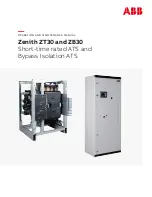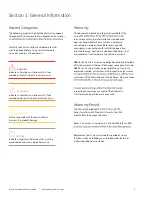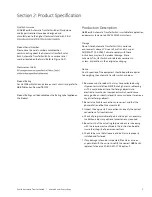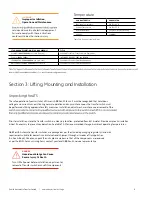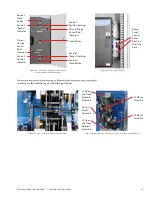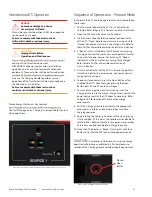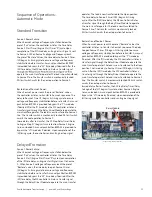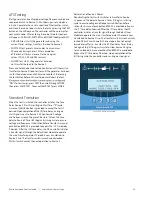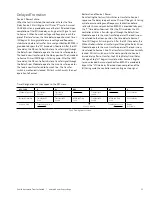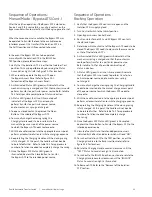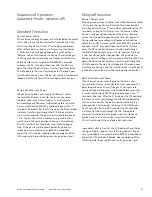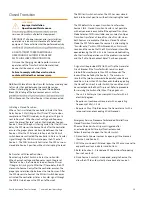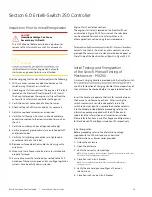
13
Zenith Automatic Transfer Switch | new.abb.com/low-voltage
Sequence of Operations –
Automatic Mode
Standard Transition
Source 1 Power Failure:
When Source 1 voltage or frequency has fallen below the
preset “Fail” values, the controller initiates the Time Delay.
Source 2 Start Timer (Engine Start Timer “P”) cycle. Upon
completion of the (P) time delay, an Engine start Signal is sent
to Source 2. When Source 2 voltage and frequency reach
the preset “Restore” Values, the time delay to Source 2 Timer
(W) begins its timing cycle to ensure voltage and frequency
stabilization before transfer. A manual pushbutton BYPASS
is provided to bypass the “W” time delay if desired. After the
(W) time delay, the MX controller initiates a transfer signal
operate the main transfer operator. The load is now transferred
to Source 2 line. The transfer switch is mechanically locked.
SN limit switch waits for the next operation to Source 1.
Restoration of Source 1 Power:
When Source 1 power reach the preset “Restore” values,
the controller initiates re-transfer to Source 1 sequence. The
delay to Source 1 Timer (T) begins its timing cycle to ensure
voltage and frequency stabilization before retransfer. A manual
pushbutton BYPASS is provided to bypass the “T” time delay
if desired. After the (T) time delay, the MX controller initiates a
transfer signal through the Relay Driver Module to operate the
main transfer operator. The load is now transferred to Source 1
line. The transfer switch is mechanically locked. SE limit switch
awaits the next operation to Source 2.
Immediately after re-transfer, the S2 Stop Delay Timer (Delay
to Engine Stop “U”) begins its cycle to allow Source 2 Engine
to run unloaded. A manual pushbutton BYPASS is provided to
bypass the “U” time delay if desired. Upon completion of the
(U) timing cycle, the controller sends an Engine stop signal.
Delayed Transition
Source 1 Power Failure:
When Source 1 voltage or frequency has fallen below the
preset “Fail” values, the controller initiates the Time Delay
Source 2 Start (Engine Start Timer “P” cycle. Upon completion
of the (P) time delay, an Engine start Signal is sent to Source
2. When Source 2 voltage and frequency reach the preset
“Restore” values, the time delay to open Source 1 timer
(W) begins its timing cycle to ensure voltage and frequency
stabilization before re-transfer. A manual pushbutton BYPASS
is provided to bypass the “W” time delay if desired. After the
(W) time delay, the MX controller initiates a transfer signal
through the Relay Driver Module to operate the main transfer
operator. The load is now transferred to the Open position.
The time delay to Source 2 timer (DW) begins its timing
cycle. After the (DW) time delay, the MX controller initiates
a transfer signal through the Relay Driver Module to operate
the main transfer operator. The load is now transferred to
Source 2 line. The transfer switch is mechanically locked.
SN limit switch awaits the next operation to Source 1.
Restoration of Source 1 Power:
When Source 1 power reach the preset “Restore” values, the
controller initiates re-transfer to Source 1 sequence. The delay
to open Source 2 Timer (T) begins its timing cycle to ensure
voltage and frequency stabilization before retransfer. A manual
pushbutton BYPASS is provided to bypass the “T” time delay
if desired. After the (T) time delay, the MX controller initiates a
transfer signal through the Relay Driver Module to operate the
main transfer operator. The load is now transferred to the Open
position. The time delay to Source 1 timer (DT) begins its timing
cycle. After the (DT) time delay, the MX controller initiates a
transfer signal through the Relay Driver Module to operate the
main transfer operator. The load is now transferred to Source 1
line. The transfer switch is mechanically locked. SE limit switch
awaits the next operation to Source 2.
Immediately after re-transfer, the S2 Stop Delay Timer (Delay
to Engine Stop “U”) begins its cycle to allow Source 2 Engine
to run unloaded. A manual pushbutton BYPASS is provided to
bypass the “U” time delay if desired. Upon completion of the
(U) timing cycle, the controller sends an Engine stop signal.
Figure S4-9 : Electrical Panel
Relay Module

